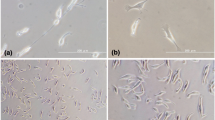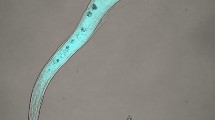Summary
A method for in vitro cultivation of teratocytes from the egg parasitoidTelenomus heliothidis (Hymenoptera: Scelionidae) is described. Parasitoid eggs, from which teratocytes were derived, were collected from 24-h-oldHeliothis virescens (Lepidoptera: Noctuidae) eggs previously parasitized byT. heliothidis females. Optimal culture conditions, including species and concentration of serum, were determined experimentally. Thirty percentManduca sexta hemolymph or 10% chicken serum in Hink’s TNH-FH medium were found to generate the most satisfactory number of teratocytes per parasitoid larva. Teratocytes cultivated in vitro showed similar development and morphology to those produced in vivo. However, cultured teratocytes lived approximately 10 times longer than teratocytes in natural hosts and were not dependent upon the presence of the parasitoid larva for normal development.
Similar content being viewed by others
References
Askew, R. R. Parasitic insects. New York: American Elsevier Publishing Co.; 1971.
Cohen, A. C.; DeBolt, J. W. Fatty acid and amino acid composition of teratocytes fromLygus hesperus (Miridae: Hemiptera) parasitized by two species of parasites,Leiophron uniformis (Braconidae: Hymenoptera) andPeristenus stygicus (Braconidae: Hymenoptera). Comp. Biochem. Physiol. 79B:335–337; 1984.
Gerling, D.; Orion, T. The giant cells produced byTelenomus remus. J. Invert. Pathol. 21: 164–171; 1973.
Ivanova-Kasas, O. M. Polyembryony in insects. Counce, S. J.; Waddington, C. H., eds. Development systems: insects. New York: Academic Press; 1972:243–271.
Norton, W. N.; Vinson, S. B. Synbthesis of the vitelline and chorionic membranes of an ichneumonid parasitoid. J. Morphol. 174:185–195; 1982.
Salt, G. The resistance of insect parasitoids to the defence reactions of their hosts. Biol. Rev. 43:200–232; 1968.
Sluss, R. R.; Leutenegger, R. The fine structure of the trophic cells ofPerilitus coccinellae (Hymenoptera: Braconidae). J. Ultrastruc. Res. 25:441–451; 1968.
Spurr, A. R. A low-viscosity epoxy resin embedding medium for electron microscopy. J. Ultrastruc. Res. 26:31; 1969.
Strand, M. R.; Meola, S. M.; Vinson, S. B. Correlating Pathalogical symptoms inHeliothis virescens with development ofTelenomus heliothidis. J. Insect. Physiol. In press.
Tremblay, E.; Calvert, D. New cases of polar nuclei utilization in insects. Ann. Soc. Entomol. France (N.S.) 8: 495–498; 1972.
Vinson, S. B.; Scott, J. R. Ultrastructure of teratocytes ofCardiochiles nigriceps Viereck (Hymenoptera: Braconidae). Int. J. Morphol. Embryol. 3:293–304;1974.
Vinson, S. B.; Iwantsch, G. F. Host regulation by insect parasitoids. Quart. Rev. Biol. 55:143–165; 1980.
Author information
Authors and Affiliations
Rights and permissions
About this article
Cite this article
Strand, M.R., Quarles, J.M., Meola, S.M. et al. Cultivation of teratocytes of the egg parasitoid telenomus heliothidis (hymenoptera: Scelionidae). In Vitro Cell Dev Biol 21, 361–367 (1985). https://doi.org/10.1007/BF02623466
Received:
Accepted:
Issue Date:
DOI: https://doi.org/10.1007/BF02623466




